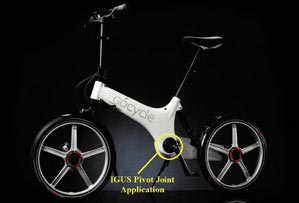Maintenance free pivot joint for a bicycle
In most cases, current state of the art bicycle frames are fitted with rear wheel suspension or pivotable joints that allow the bicycle frame to be folded in a single plane or made more compact for easy storage. ® The majority of rear wheel suspension bicycle frames have a movable swinging arm attached to the real wheel and connected to the main bicycle frame by means of a bearing pivot joint. These pivot joints must allow the swinging arm to oscillate rotationally about the axis of the pivot joint to allow the rear wheel to move up and down with respect to the ground, whilst simultaneously minimising lateral movement at the pivot joint. The problem with bicycle frame pivot joints is that excessive lateral movement in the pivot joint can develop over time as the frame pivot joint is moved back and forth through the course of normal suspension operation, or folding of the bicycle frame. Once excessive lateral play has developed in the frame pivot joint, the bicycle will feel unsafe to ride and, if the bicycle pivot joint does not have some form of adjustment to compensate for wear or allow the user to tighten the joint, the bicycle pivot joint will need to be replaced with new bearings. The mechanism developed by Karbon Kinetics overcame these problems. Steel needle roller or ball roller type bearings involve high manufacturing costs and increased weight – both undesirable qualities for a bicycle. iglidur® plain bearings were found to be maintenance free, low cost and lightweight, which were qualities ideally suited to Karbon Kinetics’ self-adjusting bicycle frame pivot joint.

Andrew Grogono
Managing Director
Karbon Kinetics